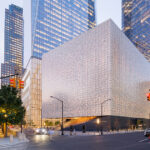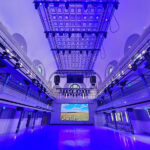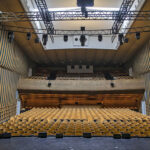One of the biggest issues facing Asbury United Methodist Church a few years back was parking space. The fast growing church was severely challenged for places to put all of the cars carrying new worshipers. When Senior Pastor Dr. Tom Harrison heard that the ice rink adjacent to the church had become available, he didn’t give it much thought. Then, one day, he drove through the parking lot and started counting parking spaces. He counted 220 of them.
When Harrison realized the potential for the additional parking, he told executive director Dwight Yoder about the availability. Much to Harrison’s surprise, Yoder revealed that he had a vision for the now empty rink. His vision was to transform it into a venue for great music, world-changing projects, and the center of the church youth community. Within a short time, the church had purchased the building and lot, renovated it, and re-launched it as Venue 68 in honor of Yoder’s favorite passage from the bible, Micah 6:8.
Oklahoma City-based AV-interiors (AV-i) was consulted in the early stages to design and build the audio, video, and lighting systems. For over a year, Marcus Walker and Colby Bramlett, co-owners of the company, worked on the design of the systems in conjunction with the church, the architect, the electrical contractor and the other trades.
“Asbury had a technologically advanced vision for the new facility,” said Walker, “including the desire to have it function as a stand alone intimate worship experience, a video venue satellite campus, as well as a full concert house,” Bramlett said, adding that “they wanted the system to not only meet the needs of their creative staff, but meet or exceed most of the technical riders for all of the bands they anticipate having in the facility.”
Clearly, the parking lot was going to need a lot of help from the renovation of the building to meet the needs of the church.
When the architect handed over 2D AutoCAD drawings of the building, including the 10,000 square foot youth sanctuary, AV-i went to work sketching out the system. Using LD Assistant lighting design software, they imported the AutoCAD file and began to develop a 3D model. They laid in the walls, the platform, the risers, and the soft goods. Then they went about designing the lighting system.
“The primary goal of the lighting system was to provide enough lighting to see the band on the platform and then to have enough color and projection to transform the music into a concert experience. In a lot of churches, the video wash takes precedence, and that tends to wash out a lot of the eye candy — the color, the projection, and the effects. But in this case, we wanted there to be enough light for IMAG, but still have enough contrast to make the colors and projections pop.”
In order to create a more three-dimensional look on the platform, Walker and Bramlett came up with the idea to create spatial lighting positions by using truss towers of varying height. On top of each truss tower a single moving light would provide aerial beams and effects as well as allowing them to splay the softgoods behind them. Two more moving lights were positioned on the downstage lip of the platform for side lighting and to give it more of a concert feel.
Video projection screens were placed offstage right and left and two Panasonic PT-DW5100U projectors provided graphics support. A larger 16-foot wide center electric projection screen was placed upstage center and a Panasonic PT-DW7000U-K projector was specified to supply the satellite campus video feed to the facility. Two 52-inch flat panel LCD monitors were rigged on the upstage truss towers to provide a more graphics-intensive look and to provide front fill video coverage to the first two rows of seating. Three light natural velour backdrops with 100 percent fullness were brought in to provide more surfaces for color wash and projection.
After several months of design meetings, presentations, and associated budget discussions, AV-i created conceptual renderings for final approval from the church committee. When the church approved the design and associated budget, they fully understood what was going to be installed and how the final product would “look.” In the end, the design included 28 ETC Source Fours of varying beam angles, 16 PAR 64s, six Martin MAC TW1s, four MAC 575 Kryptons, two MAC 250 Kryptons, and two MAC 250 Washes. The control console was a Leprecon LPX-48 and the dimmer packs were Leprecon VX-2400s.
The video suite was designed around a volunteer based approach to include several workstations equipped with Production Intercom and Sony upstream LCD video monitors. AV-i used two Edirol V-44SW video switchers due to the limited rack space and ease of volunteer operation. IMAG camera connectivity was provided in three main locations on the floor as well as several other locations throughout the room for future roaming cameras and jib shots.
“One of the most unique aspects of this project,” said Walker, “was the fact that it still functions as a satellite campus, or video venue, although it is physically across the parking lot from the broadcast campus.” A fiber optic audio and video infrastructure was implemented to deliver the main pastoral message to this venue. “Not only is this fiber optic feed bi-directional,” said Bramlett, “it can be transmitted live or time delayed to suit the programming that is going on during the services in each venue. This allows the venues the ability to not be completely dependent upon service programming and timing for smooth productions.”
AV-i came in to install the infrastructure and oversee the electrical installation a month before the scheduled opening. The electrical contractor ran the dimming circuits from the electrical closet to the raceways rigged 22 feet in the ceiling of the sanctuary. They carefully numbered each circuit and terminated the dimmers. Everything went smoothly and in two weeks the AV-i crew was receiving gear and rigging it in the ceiling. Four days before the first service everything was rigged and working properly. All that remained was to focus the lights, program the console, dial in the video and train the staff.
“The idea behind using the Leprecon console,” said Bramlett, “was to create a platform that is easy for volunteers to use. We wanted to stuff the console with as many different looks as possible and give them easy access to them. Also, the 24 conventional faders at the top of the console and the 12 preset playbacks makes it easy for them to grab a fader and bring up the house lights, the stage wash, or any number of preset looks.”
It took about a day to focus and gel the conventional lights, then another day to set up the console with all the presets including focus positions, colors, gobos, and effects. The last couple of days were spent getting as many looks as possible into the console and training the staff to play them back as well as to program their own looks.
Coordination in the video suite was simple. Once the staff arrived for the introduction to the system, they were assembled in their respective workstations and were trained individually on their specific tasks.
On the Saturday morning before the first service, the risers were brought in and the band set up. That was the first time the AV-i crew got a look at the final layout on the platform. Then a quick run through of program for the first service provided a quick opportunity to prepare for the big event.
Early Sunday morning of the first service in the new facility, the AV-i crew arrived on site to start the system. The band started filing in about an hour later for one last run through before the doors opened for the first time. It was then that the final video content and worship graphics were delivered by Asbury’s creative team and put up on the screens for the first time.
It would have been easy for the AV-i crew to panic, given that the new video content didn’t quite match the colors that were programmed for the seven songs to be played during the service. Instead, they went to work to change the programming.
“We were programming right up until the doors opened, and it was a race between us and the doors. Fortunately, we programmed using preset color palettes, so we just had to go through the material slide by slide and try to match the colors on the screen or throw up complementary colors.”
By the time the band played the first downbeat, it looked as if they had spent weeks, not hours, programming the lights and preparing the video.
“The TW1s really put out a lot of light, so we could wash the entire backdrop with just a couple of them and use the other ones to create big fat aerial beams with color. I wish we had more of them. But the combination of those with the 575s and even the 250s worked well because of their relative positions on the platform.”
Chris Cleveland led the band while a capacity house filed into the new sanctuary. When the service began, Pastor Harrison recounted how he had once driven through the parking lot of the former skating rink counting parking spaces. But on that day, he was counting heads and hearts in the house.
“We usually have a walk in look when the doors open to welcome people into the space. And we could hear them kind of gasp when they first saw the place. I wish that we could have saved the lighting for the first song so we could hear the collective gasp.”


